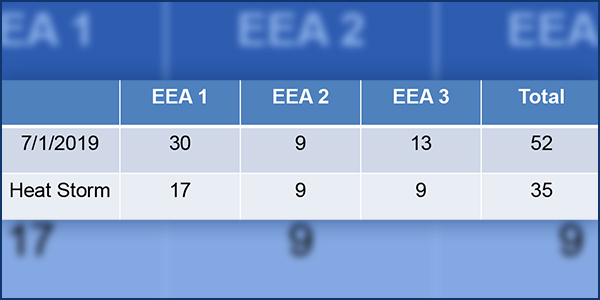RC West praised its members for collaborating to manage the Western “heat storm” in mid-August that prompted CAISO to initiate California’s first rolling blackouts since the energy crisis of 2000/01 and pushed utilities elsewhere to the brink of calling for outages.
“The first point I want to make is the only place that firm load-shed did occur was in California,” Tim Beach, director of reliability coordination for RC West and CAISO, told the RC West Oversight Committee on Tuesday.
While other balancing authority areas “within the RC West area didn’t have firm load shedding … they were a contingency away, perhaps. Many times, it was imminent, and that’s why they were in” a Level 3 energy emergency alert (EEA 3), Beach said.
To give a sense of the scope of the event, Beach noted that RC West BAs have called 52 EEAs since the reliability coordinator commenced operations in 2019. Out of those 52 EEAs, 35 occurred during the Aug. 14-18 heat wave.
“So, it was a very large-impact heat storm that was stalled across the region,” he said.
The heat wave produced the all-time record peak demand in RC West’s short history: 127.6 GW on Aug. 17. WECC, which is performing an event analysis for NERC and stakeholders, estimates that demand across the entire Western Interconnection peaked at just over 162 GW on Aug. 18. (See WECC Examining August Heat Wave Through West-wide Lens.)
Beach noted that RC West is still responding to data requests for WECC’s analysis. “We expect to get some lessons learned out of that [report] as well.”
He shared some of the lessons RC West already gleaned based on firsthand experience with the event.
The first lesson was the benefit of “proactive communication” across the interconnection. Beach said RC staff initiated “ad hoc” daily conference calls with BAs and transmission operators (TOPs) throughout the event. Calls started as early as 3 a.m., with RC “canvassing” BAs and TOPs in the Southwest and Pacific Northwest about any potential capacity issues they might expect that day.
“We used those calls to sort of cue [RC staff] to follow up with other individual companies as the day progressed,” Beach said.
He offered a “hats off” to BA and TOP operators for “doing an excellent job” of joining conference calls during the day and communicating the status of the system.
“It was in some respects a good event that everybody sort of linked their arms together and we marched through the heat storm and were able to manage it pretty well,” Beach said.
RC West’s second key lesson was recognizing the need for bringing in relief, as it added shift staff to assist with peak hours.
“Normally we have three RCs [operating staff] on shift — a lead and two regular RCs,” Beach said. “We brought a fourth RC that usually started around noonish and then actually worked well through peak up until 10 at night to help with the RCs on staff.”
He said the first objective of EEAs is to help BAs navigate capacity emergencies. The second — “which is probably equal to the first” — is to protect the wider interconnection from a BA “that’s in trouble.”
Beach wants to ensure that staff provide a “proper sounding board” for BAs as they escalate to emergency procedures. He said at times he thought RC West’s approval of EEAs during the event was “more like a rubber-stamp.”
“I would’ve liked to have a little more rigor around that, so we’re going to look at that going forward,” he said.
Beach said RC West this year began performing capacity drills with individual BAs to walk through EEA steps, explore scenarios of reserves deficiency or sufficiency, and examine ways to work through capacity emergencies.
“Then we can exercise some muscle memory going into next year,” he said.
Controlled Control Room
CAISO has reactivated a third control room in order to protect staff against potential COVID-19 infections as cold and flu season looms.
“If we do have somebody that has a sick child at home, for example, we don’t have to quarantine them at home. We can put them in a controlled environment, and they can still operate from that control room,” Beach said, adding that the room is “physically cordoned off” from the rest of the ISO population.
Beach assured the Oversight Committee that CAISO staff remain healthy and have not registered a single COVID case, despite some direct contacts with infected people. “But we have a process for making sure we quarantine those people in those instances,” he said.





